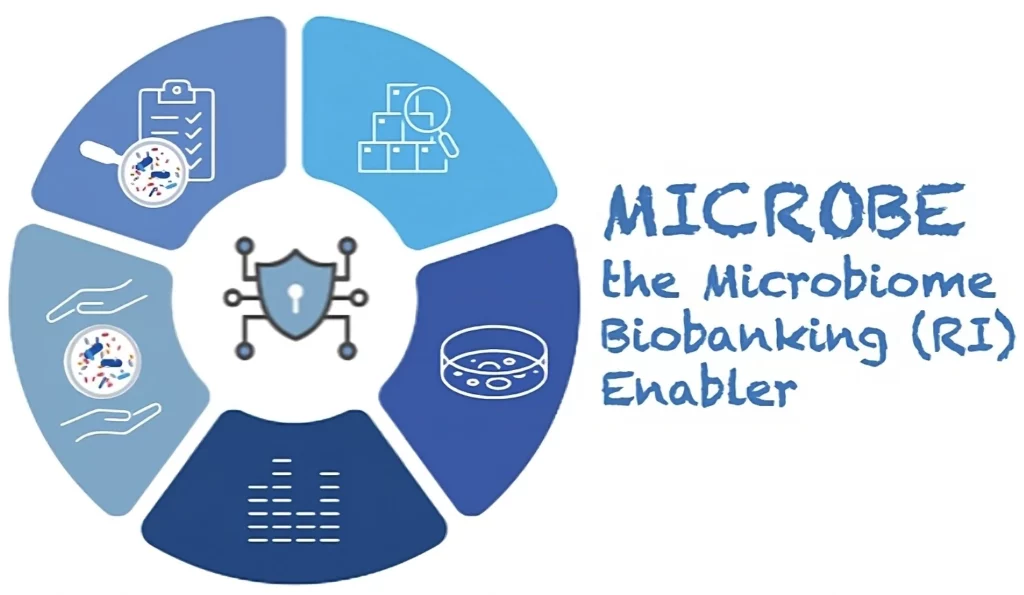
#EBW24 Editorial: MICROBE – MICRObiome Biobanking (RI) Enabler
This article comes from the MICROBE team. You can read about the project here – it kicked off in March 2023 at BBMRI.at.
Microbiomes comprise communities of microorganisms (i.e., bacteria, archaea, protists, fungi and microalgae) and their “theatre of activity” (i.e., structural elements, metabolites, signal molecules, mobile genetic elements (such as viruses), as well as surrounding environmental conditions)1. They are in and on humans, animals, soil, water, and plants.
Microbiomes play a key role in maintaining life on Earth by providing a range of essential ecosystem services and are indispensable for the functioning and health of humans, animals, and plants2,3. There is wide consensus that by harnessing microbiome functions, society would be better placed to tackle global challenges such as food security, health and wellbeing, food waste management, and climate change mitigation4. This has led to an increasing interest in the microbiomes also in the context of the One Health concept5.
To facilitate the science necessary to achieve key advances in microbiome research, methodologies and technologies to capture or create, ensure stable long-term maintenance, and experimentally perturb microbiomes, are required. Europe has an illustrious track-record of developing infrastructure for the biobanking of living microbial resources (as reflected pan-European research infrastructures, involved in this domain, four of which – including BBMRI-ERIC – are linked with the EU Project MICROBE).
However, culture collections have traditionally exclusively focussed on the maintenance of ‘pure’ strains. Biobanking of complex microbiome samples has been initiated in the medical sector, e.g. by the Microbiota Vault Project or the Global Microbiome Conservancy initiative. Across other biological domains (e.g. environmental microbiome area), research infrastructures currently lack optimised methodologies and technologies to preserve and provide access to microbiome samples and massive amounts of associated data.
The biggest technological bottleneck is the development of optimised methodologies for the preservation of microbiomes and for assessment of the success of preservation in terms of maintaining the composition and functionality of microbiomes6. There is also an imminent need for the establishment of a unified data infrastructure to support microbiome research and innovation, as well as implementation of standardisation across sectors7.
MICROBE aims to address these issues and deliver technical solutions for microbiome preservation, propagation and functionality assessment that enable optimal collection and preservation of microbiome samples and allow targeted isolation of microbiome members that retain the functional diversity of original microbiomes. Overall, MICROBE will provide a comprehensive operational blueprint for the establishment of a microbiome biobanking infrastructure, including technological requirements, methodological workflows, data pipelines, pre-analytical sample quality requirements for standardization, legal and ethical guidelines, and business opportunities.
Therefore, it is important for MICROBE project partners to attend the Europe Biobank Week. This gives the opportunity to reach out to the biobanking community and raise awareness on the relevance of microbiome samples and the current challenges associated with microbiome biobanking.
On the other hand, it is important for MICROBE to link with research infrastructures such as BBMRI-ERIC (in addition to MIRRI, ELIXIR and EMBRC-ERIC) to ensure that community needs are properly addressed and that developed solutions are efficiently taken up by the infrastructures themselves and by their user communities. Long-term ambition is to ensure widespread uptake of developed methods and guidelines in microbiome research communities and to enable RIs to support this field, ultimately enabling the development of novel microbiome-based applications.
Meeting the MICROBE team at this year’s EBW by booking your ticket.
References
1 Berg et al., Microbiome (2020), doi: 10.1186/s40168-020-00875-0
2 EU Science & Innovation (2019), https://youtu.be/cjGMazveejE
3 Stark, CBE: Life Sciences Education (2010), doi: 10.1187/cbe.10-09-0119
4 d’Hondt et al., Nature Microbiology (2021), doi: 10.1038/s41564-020-00857-w
5 Ling-chao Ma et al., Science in One Health (2023), doi.org/10.1016/j.soh.2023.100037
6 Ryan et al., Trends in Microbiology (2021), doi: 10.1016/j.tim.2021.01.009
7 Ryan et al., Environmental Microbiology (2021), doi: 10.1111/1462-2920.15323
8 Stumptner et al. (2021), doi: 10.3390/nu14091976